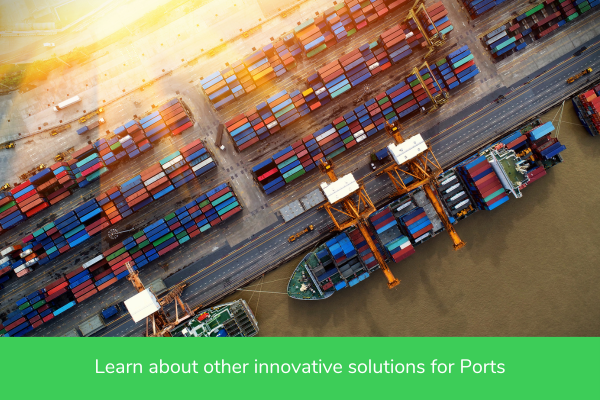Demand for electricity in ports is increasing – for example, the UK predicts its ports will need 10x more electricity by 2050
Demand for electricity in ports has massively increased due to the electrification of ships at berth and of equipment like vehicles and cranes in the port. For example, in the UK, port electricity demand is expected to increase from around 20 GWh/year in 2016 to 250 GWh per year by 2050.
This will require ports to build new electrical distribution infrastructure and implement new processes to support electrification. To optimize performance, these green ports also need to be able to monitor, manage, and maintain their installations. This is a challenging undertaking because changes to the electrical distribution system can be complex and need to be made without comprising uptime.
Ports have many areas that are prime for electrification
Ports have many opportunities to electrify, including:
- OPS (Onshore power supply) also known as cold ironing or shore to ship power connection
- Mobile crane electrification (eRTG)
- GSV (Ground support vehicle), cargo handler equipment, stackers, forklifts
Rising demand is primarily driven by the shift from fossil fuels to electrified processes
The main driver of electrification is the need to meet decarbonization goals and stay compliant with regulations and initiatives. Ports are subject to green regulations that require increased port electrification, particularly in getting ships at berth to use electricity instead of fossil fuels.
These regulations include geographic areas such as the FuelEU Maritime initiative and the U.S.’s Clean Shipping Act of 2022 bill. For example, the FuelEU Maritime initiative aims to reduce the industry’s carbon footprint by increasing the use of renewable and low-carbon fuels (RLF) in the EU’s maritime sector. The initiatives also introduces an additional zero-emission requirement at berth, mandates the use of an on-shore power supply or alternative zero-emission technologies in ports by passenger ships and container ships.

But, while electrification is a positive environmental change, ports’ current electrical distribution systems were not designed for such heavy electricity loads
Ports’ current electrical distribution systems were not built to handle this much power demand. This is a major concern for shipping companies and ports. For example, in a study by the UK Chamber of Shipping (the trade association for UK shipping) nearly 80% of respondents reported that the lack of port infrastructure is a barrier to green shore power. Those surveyed cited this as the top reason why they wouldn’t plan on installing shore power technology on their vessels.
This survey shows that strengthening and preparing for electricity needs must be a priority to get shippers buy-in. For instance, electrical distribution systems need to support shore power so that ships at berth can shut down their diesel engines and plug into the power grid. Ports also need to install specialised EV charging infrastructure to charge equipment like mobile cargo cranes and container terminal transport.
Digital power and energy management tools help manage the impact on ports’ electrical networks and support real-time system monitoring
Preparing electrical distribution systems for increased energy demand isn’t just about adding physical assets. A green, electrified port also depends on digitization and energy management to safeguard assets and maximize uptime.
Why is monitoring important?
- Power monitoring technology uses connected digital devices, like sensors, to gather data that is analyzed to remotely monitor facilities, assets, and power network functionality.
- It helps ports maximize uptime and operational efficiency by providing a real-time look at assets’ and power networks’ health status. This helps identify faults before failure and analyzes problems’ root cause so that ports can recover quickly and prevent recurrences.
- It allows ports to make energy-management decisions based on relevant, accurate, and reliable data. Digitally connected meters, in combination with centrally managed sustainability and energy tools, measure energy consumption and calculate saved CO2 emissions.
- Remote data monitoring brings visibility to ports’ energy profile at the terminal and/or port level so energy consumption can be continuously monitored, measured, and analyzed down to the load level.
How does monitoring lead to better management?
- Using the monitoring data, port operators know how their electrical distribution infrastructure and assets are performing, which allows them to better manage it.
- For example, they can use the data analysis to track real-time and historic data, identify areas to maximize operators’ efficiency, uncover energy inefficiencies, secure business continuity and track where and how energy is being used.
- Connected products, combined with a range of control solutions, energy management and digital services, help ports better manage the new electrical infrastructure.
- Digital twins bring up-to-date visibility of ports’ electrical distribution installation and allow ports to perform technical studies.
How does monitoring and improved management lead to better maintenance?
- Condition-based maintenance gives port operators peace of mind because they know equipment is being monitored and maintained.
- It extends assets’ lifespan.
- Service plans can provide on-site and remote services to support maintenance teams.
Port of Montreal is improving sustainability with a shore-to-ship power solution
Schneider Electric’s shore-to-ship power solution is helping the Port of Montréal, Canada’s second-largest port, to reduce its carbon footprint and reach optimal port efficiency. This improves sustainability because the solution allows cruise ships and wintering ships at berth to shut down their diesel engines and plug into the clean Canadian power grid. The Port predicts these changes will reduce greenhouse gas emissions by 2,800 tons annually, the equivalent of around 350 homes’ energy use for one year.
The Port of Montreal is using our solutions to optimize and modernize operations throughout the port lifecycle. The shore-to-ship power connection requires high network stability and safe operation procedures. Using EcoStruxure Power Operation and EcoStruxure Power Monitoring Expert technology allows port operators to monitor protection settings accurately, validate automated connection procedures, log energy consumption, and operate remote electrical equipment.
The Port is also improving power reliability using EcoStruxure Power Advisor, a cloud-based energy management diagnostic service that improves power reliability. Using analytics algorithms, our team of experts finds, prioritizes, and recommends ways to resolve problems that impact electrical infrastructure performance, such as those that may result from network reconfiguration due to future shore connection expansion.
Learn about other innovative solutions
Learn more about our solutions for ports.
Continue the conversation with our new leader for Transportation
I’m excited to introduce Tam Osentowski, Schneider Electric’s new leader for Transportation. In upcoming blogs, she’ll share her insight on how ports can decarbonize, improve operational efficiency, and increase cybersecurity.



